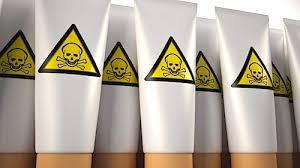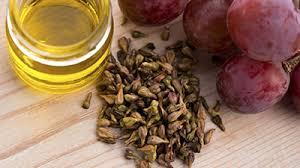- posted: Jan. 17, 2017
Commonly Used Toxic Ingredients:
Sadly, the list of toxic ingredients that are included in skincare, cleaning products, cosmetics etc. is very long. This is not an exhaustive list, but it is a great place to start especially if you are new to avoiding toxins in topical products.

Phthalates
Phthalates are group of chemicals which can act as endocrine disruptors. They have been linked to an increased risk of breast cancer, reproductive birth defects, and early breast development in girls. Phthalates are found in many cosmetic products and plastics. Phthalates are often listed as “fragrance” in product ingredients. We recommend choosing unscented products, or products which are scented with pure essential oils.
Formaldehyde
Formaldehyde is a colorless, strong-smelling, flammable chemical that is used in building materials and household products. It is also used as a preservative in many cosmetics. It has been found to be a carcinogen and is linked to allergic skin reactions and immune system disruptions.
Parabens
The most common parabens are butylparaben, methylparaben, and propylparaben. Parabens are commonly used as preservatives in cosmetics and skin care products as they prevent bacteria, mold, fungus, and parasite growth. The problem is that parabens are easily absorbed by the skin and are associated with breast and prostate cancer.
Triclosan
Tricloson is a skin irritant associated with disrupting the function of thyroid and reproductive hormones. It is commonly used in products for its antibacterial and antifungal properties and is found in many toothpastes, deodorants, detergents, and antibacterial soaps.
Sodium lauryl sulfate (SLS) and
Sodium laureth sulfate (SLES)
These surfactants are found in over 90 percent of personal care products, namely foamy products. SLS has been found to be a skin and eye irritant. SLES can also irritate skin and eyes, but to a lesser degree. The real problem with SLES is that it is frequently contaminated by a carcinogen called 1,4 dioxane during the manufacturing process. Also, SLES cannot be metabolized by the liver, so it remains in the body for much longer than SLS.
Benzoyl Peroxide
The FDA warns that the use of products containing benzoyl peroxide can cause rare but serious allergic reactions or severe irritation. Some of these reports described severe allergy symptoms such as throat tightness, shortness of breath, wheezing, low blood pressure, fainting or collapse. Isolated instances of hives, itching of face or body, and swelling of eyes, face and lips. There are also cases linking benzoyl peroxide to skin cancer as it promotes the generation of free radicals.
Coal Tar
Coal tar derivatives are found in shampoos and scalp treatments, soaps, hair dyes, and lotions. Coal tar is a known carcinogen derived from burning coal. It is a complex mixture of hundreds of compounds. Studies have found that exposure to coal tar can produce skin tumors, cause neurological damage, birth defects and immune system toxicity. 'Coal Tar' can be listed as petrolatum, xylene, toluene, mineral oil, liquid paraffin, benzene, toluol, phenylmethane, and methylbenzene on ingredient labels.
Methylisothiazolinone (MIT)
MIT is a common antibacterial preservative with neurotoxic properties. It can cause severe damage to our brain cells and increases the risk of seizures. It is included in many products including cosmetics, lotions, moisturizers, sanitary wipes, shampoos, and sunscreens.
Propylene glycol (PEG)
PEG is available in varying grades. When classified as industrial grade, it is an active ingredient in engine coolants and antifreeze; airplane de-icers; polyurethane cushions; paints, enamels and varnishes. It functions as a solvent or surfactant. In this industrial state, PEG is classified as a toxin. It is also often used as a moisturizing agent in body lotions, sunscreen, makeup products, conditioners, and shampoos. When used in topical products, it is classified as a skin irritant and is associated with dermatitis and hives.
Artificial Dyes
FD&C and D&C stand for 'food, drugs, and cosmetics', and 'drugs and cosmetics.' These labels are used in ingredient lists as a statement of artificial pigments in products. When FD&C color pigments are applied to the skin, some may experience external irritation or sensitivity. This is due to the toxic heavy metal salts used to create these artificial pigments. Many of these dyes are also carcinogenic.
Imidazolidinyl Urea
Imidazolidinyl urea is added to most water-based cosmetics as a preservative. It releases formaldehyde and has been linked to skin irritation and cancer. It is linked to allergies, chest pain, chronic fatigue, depression, dizziness, ear infections, headaches, joint pain, loss of sleep, and can trigger asthma. It is commonly found in nail polish, antiperspirants, skin and hair products.
Sunscreen Chemicals
Most commercially available sunscreens are loaded with chemical compounds including oxybenzone, avobenzone, octisalate, octocrylene, homosalate and octinoxate to name a few. These compounds are linked to cell damage, disruption of the endocrine system, and cancer.
Endocrine disruptors can cause abnormal development of fetuses and growing children. They can cause early puberty and premature breast development in girls, and small, undescended testicles in pubescent boys. They can cause low sperm counts and infertility. Endocrine disruptors that act like estrogen can contribute to the development of breast and ovarian cancers in women, and may increase the chance of prostate cancer in men.
It is important to note that there are options to physically block solar rays as opposed to chemically blocking them. Titanium dioxide and zinc oxide sit on the surface of our skin, physically blocking or reflecting broad spectrum UVA and UVB rays. We also want to note that we don't need to block the sun completely. Roughly 20 mins of sun exposure per day helps us to boost our vitamin D levels and can help with mood stabilization.
Healthy, Natural Alternatives:
Here is a list of natural, healthy, and effective alternatives to maintain even tone, prevent wrinkles, and hydrate skin!

Tea Tree Oil
Tea tree oil fights fight breakouts and inflammation on the skin. It is usually well tolerated in those who are acne-prone. Tea tree oil uses include working as a natural anti-inflammatory, anti-bacterial, antimicrobial and anti-fungal.
Coconut Oil
Coconut oil provides a long list of skin benefits including strengthening epidermal tissue, removing dead skin cells, and protecting from sunburn. It has antibacterial, antiviral, antifungal and antioxidant properties. Coconut oil can be used on skin and hair as a moisturizer, conditioner, or make-up remover. It also prevents razor burn and is rich in healthy fats.
Avocado
Avocados are hydrating and are rich in vitamins A, D and E which are all able to penetrate the skin. They can help to boost collagen production and treat age spots. The vitamins in avocados also work to reduce inflammation of the skin when applied topically and can do the same internally when eaten. An avocado face mask is a great way to replenish hydration and supply the skin with vitamins and antioxidants.
Apple Cider Vinegar
Apple cider vinegar is a versatile, natural skin care product. Its benefits include killing bacteria and other pathogens on the skin, and helping to heal acne. It also provides antifungal properties. It contains highly beneficial acetic acid and certain vitamins including potassium and magnesium. Apple cider vinegar is considered a detoxifying agent when consumed internally, since it boosts liver function and helps balance gut flora.
Sea Salt
Sea salt is rich in minerals and nutrients like magnesium, calcium, sodium and potassium. Sea salt contains anti-inflammatory agents which soothe skin, calm breakouts, balance oil production, and help the skin retain moisture. It is also great for removing dead skin cells when used as a scrub.
Lemon Essential Oil
Lemon essential oil can be used to diminish acne breakouts caused by high levels of bacteria stuck in pores. It’s also useful for fading scars and age spots, exfoliation, brightening skin tone, and fighting wrinkles.
Argan Oil
Argan oil is native to Morocco. It is rich in vitamin A and vitamin E, various antioxidants, omega-6 fatty acids and linoleic acid. It can also be applied to skin to help heal irritations such as acne, eczema, and psoriasis. Argan pil is not only great for moisturizing skin, but it also boosts the shine and health of your hair.
Aloe Vera
Aloe Vera is commonly associated with healing sunburns. It contains bacteria-fighting, soothing properties that fight inflammation, redness and itching when applied topically. It also detoxifies you from the inside out when taken orally.
Almond Oil
Almond oil not only smells great, but it has anti-inflammatory, antiviral, antibacterial, and antiseptic properties. It makes a great carrier oil for essential oils to naturally treat skin rashes, acne or dryness.
Shea Butter
Shea butter has been used as a natural skin care product in Africa for hundreds of years. It comes from the seeds of the fruit of the karite tree and is rich in vitamins A, E and F. It provides the skin with essential fatty acids and the nutrients necessary for collagen production. Shea butter is an excellent option for moisturizing dry skin and reducing flaking, redness or peeling.
Home Recipes to Try:
Firming and Anti-Aging Serum
Ingredients:
- 2 TBSP. Rosehip Seed Oil
- 2 TBSP. Sweet Almond Oil
- 10 drops of Cypress essential oil
- 10 drops of Geranium essential oil
- 7 drops of Frankincense Essential Oil
Instructions:
- Mix all ingredients in a 2 ounce dark glass bottle. You can use this serum morning and night. I prefer to only use mine at night. Like all serums, less is more. It only takes a small amount to cover your entire face and neck. If you use too much, you will feel quite greasy!
**A short and sweet recipe that will moisturize, firm the skin and even tone. It’s a well rounded anti aging serum that I’m sure you are going to love!!
Anti Wrinkle Cream
Ingredients:
- 2 tsp jojoba oil
- 1 tsp coconut oil
- 3 tsp apricot kernel oil
- 3 tsp Rosehip seed oil
- 1.5 tsp beeswax pastilles
- 6-10 tsp rose-water
Instructions
- Place beeswax, jojoba, coconut, rosehip and essential oils (basically everything besides the rose water!) in a double boiler or right in a stainless steel pan (keep your pans separate). Heat on low very gently to melt wax about 5-8 minutes.
- Stir well.
- After you you remove the ingredients from the stove (I let mine cool for a few minutes because it can be really hot.)
- Place in blender (be careful bc this can be very tough to clean out after).
- Add in the rose water a little bit at a time (through the top of the blender).
- Pulse the blender a few times and you will have a nice fluffy cream. Remember the cleanup can be MESSY! Still worth it though.
**You can double or triple the batch (if you are doing the cream version)… place in refrigerator until ready to use.
On A Related Note:
Did you know that it is common to spray pestisides in the interior of airplanes traveling from outside the US (notably New Zealand, Australia, and many countries in Africa) while the passengers are inside? We've linked a few articles/videos below.
WHO | World Health Organization
http://www.naturalhealth365.com/pesticides-toxic-chemicals-1927.html
http://www.naturalnews.com/054973_airplane_passengers_Insecticides_health_dangers.html
We are constantly being innundated with toxins. We need to take control whenever possible and reduce our exposure through our diet and product choices. You can play offense by voting with your dollars. Purchase products that are organically grown, humanely raised, and free of toxins.
Locations
6940 South Holly Circle Suite 201
Centennial, CO 80112, US
Office Hours
Our Regular Schedule
8am - 1pm
3pm - 5pm
8am – 1pm
3pm – 7pm
Closed
Closed
8am – 1pm
3pm – 7pm
8am – 2pm
Closed
Closed
Closed
Closed
Closed

